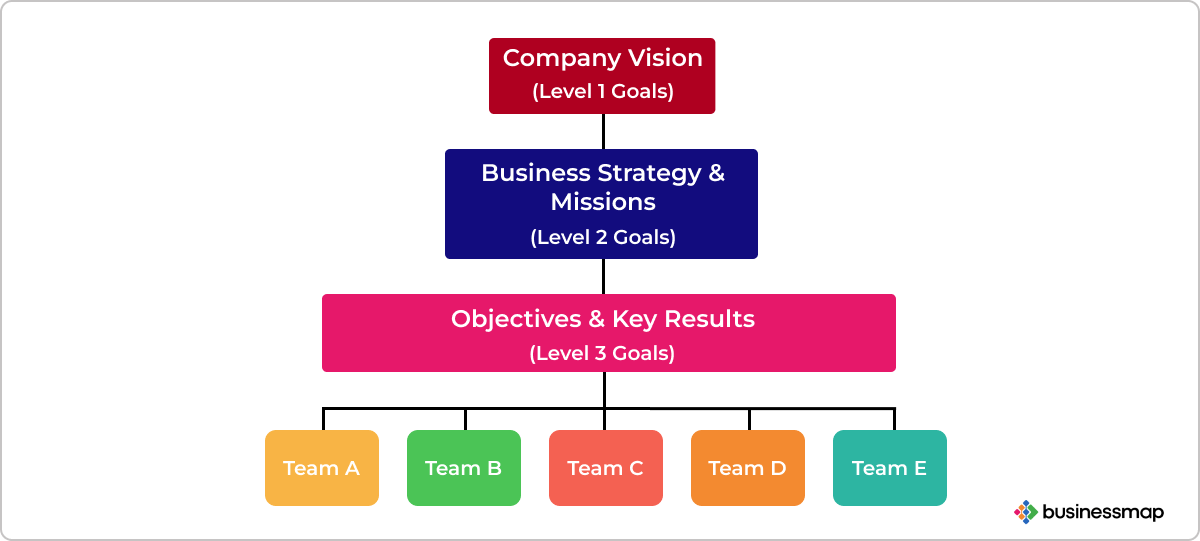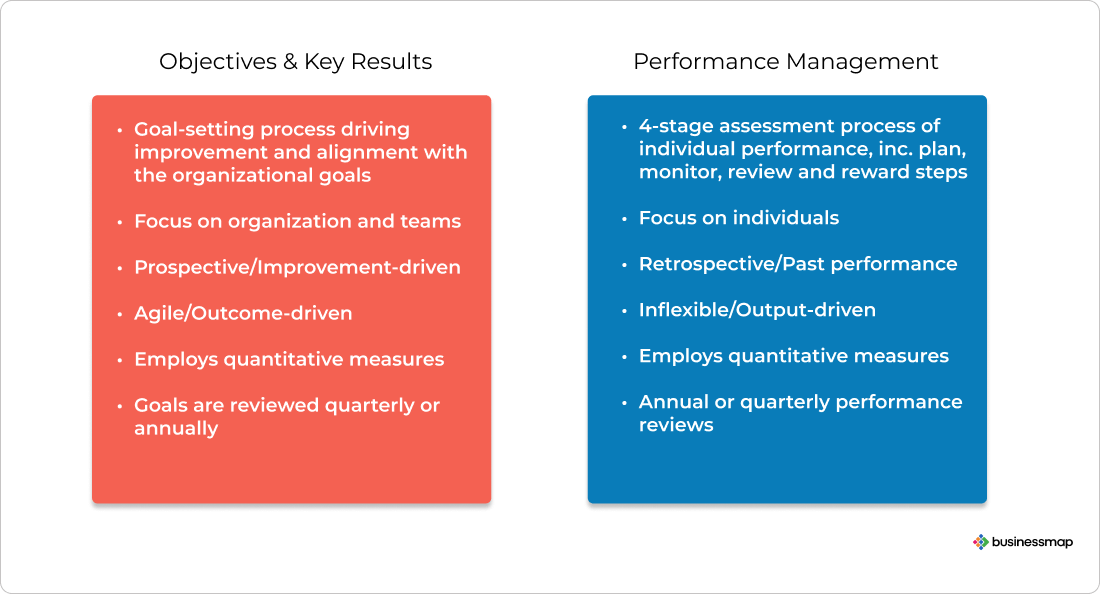Setting clear and measurable goals has become crucial in the era of ambitious goals and result-driven businesses. One of the most influential methodologies to emerge from this drive toward clarity and measurability is the Objectives and Key Results (OKRs) framework. Initially popularized in Silicon Valley, OKRs have become a critical difference in goal-setting and management by objectives across various global industries.
The OKRs cycle creates a goal-setting system that combines strategic goals and tactical objectives, fostering a result-driven company culture that keeps employees engaged and productive. They provide a platform for meaningful progress, transforming output into outcomes and enabling holistic progress toward both shared and individual objectives.
Basically, there are two types of OKRs:
- Committed
- Aspirational

Cascading objectives and key results
What Are Committed OKRs?
Committed objectives and key results (OKRs) are one of two primary types of OKRs. These are the goals an individual, team, or even the entire company commits to accomplishing within a specified time frame. Unlike aspirational OKRs, which we will discuss later, committed OKRs are typically achievable and realistic goals.
These OKRs are the bread-and-butter objectives that the organization needs to accomplish to meet its daily tasks, quarterly goals, and yearly objectives. They are well-defined goals with measurable targets and integral to the company's success. For instance, increasing the number of active users, boosting annual revenue, improving the sales team's metrics, or enhancing the product team's performance are examples of committed OKRs.
Committed OKRs call for steady progress over time, which requires regular OKR cycle check-ins, transparent internal communication processes, and frequent monitoring of the progress bar.
Examples of Committed OKRs and When to Use Them
Committed OKRs span various organizational levels and can be aligned with several types of goals. Here are a few examples:
- A sales team might commit to "Increase the annual revenue by 20%" or "Onboard 100 new enterprise customers by the end of Q3."
- A product team might commit to "Decrease the app's loading time by 50%" or "Increase the number of daily active Chinese users by 25%."
- A company might commit to "Achieve an employee satisfaction score of at least 4.5 out of 5" or "Reduce product defects by 15%."
- A customer service team looking to improve retention might commit to "Improve customer satisfaction score (CSAT) by 10 points by the end of the year."
Typically, you'd use committed OKRs for tactical goals that directly contribute to your business's success and help monitor employee performance. They work best when you need well-defined, measurable goals that push the team towards a larger goal.
What Are Aspirational OKRs?
Where committed OKRs are about consistency and steady progress, aspirational OKRs are about stretch goals and audacious ambitions. These types of OKRs push the boundaries of what seems possible, inspiring teams to aim higher, innovate faster, and achieve more. They're the objectives that might initially seem impossible but can potentially lead to huge success.
Aspirational OKRs are designed to challenge your teams to step outside their comfort zones and strive for targets that may seem out of reach. They serve as the North Star, guiding the company towards an ultimate goal.
Examples of Aspirational OKRs and When to Use Them
Aspirational OKRs might be company-wide goals that inspire innovation and risk-taking. Here are some examples:
- "Become the leading product over competitors in reputable product review publications within the next two years."
- "Increase customer satisfaction score to the industry's highest standards within the next 12 months."
- "Achieve a 50% market share in the targeted demographic within the next five years."
Aspirational OKRs are ideally used when aiming for breakthrough innovation, fostering a culture of calculated risk-taking, or targeting a significant achievement that could dramatically improve the company's standing in the market. While the risk is higher, the potential rewards of achieving these goals can be game-changing.
How to Compare Committed and Aspirational OKRs?
In the realm of Objectives and Key Results (OKRs), the notions of 'committed' and 'aspirational' hold substantial importance. Diving deeper into this comparison, it becomes clear that both types of OKRs are not a matter of better or worse. Each serves a distinct purpose and is more beneficial when employed in different contexts.
Committed OKRs stand as a beacon of certainty and assurance. They're designed to be safer, with a focus on the concrete and predictable facets of an organization's operations. The higher probability of achievement instills a sense of security, leading to consistent progress. By defining and tracking committed OKRs, teams can better align their tasks to meet operational goals that contribute to the organization's objectives.

Visualizing objective and key results (Outcomes) progress
Committed OKRs are the driving force behind the company's short-term performance. They are the gears that keep the company's engine running smoothly, directly affecting the daily operations and quarterly results. Without committed OKRs, the organization may fail to meet its routine goals, affecting its stability and reliability, e.g., an e-commerce store that isn't meeting its sales goals won't last long. Hence, these are not merely goals but commitments that reflect the company's pledge to its employees, stakeholders, and customers.
In contrast, aspirational OKRs can be viewed as the organization's moonshots. They encompass a high-risk, high-reward philosophy that propels teams out of their comfort zones. These OKRs aim to push the boundaries of what's possible, stimulating innovation and fostering a culture of creative problem-solving.
While committed OKRs hold the fort and ensure steady results, aspirational OKRs dare to dream big, often defining the company's strategic goals and long-term vision. They may not align with the company's current capabilities or even seem achievable in the near future. But, they serve as the ultimate objective, the mountain peak the company aims to scale.
Aspirational OKRs are not about immediate gains but nurturing an environment promoting exploration and exponential growth. They catalyze breakthroughs that could redefine the industry standards or how the organization operates. As such, even if an aspirational OKR still needs to be fully met, the journey toward it often leads to significant discoveries and advancements.
The dual approach of committed and aspirational OKRs offers a balanced pathway for organizations to navigate their growth journey. The committed OKRs provide structure and stability, while the aspirational OKRs inject vigor and dynamism into the organization, thus creating a symbiotic relationship that fuels sustainable growth.
Factors to Consider When Choosing Between Committed and Aspirational OKRs
Choosing between committed and aspirational OKRs is a nuanced decision. It requires a clear understanding of the distinguishing traits of these types of OKRs and an in-depth assessment of the team's and the organization's current state, future objectives, and readiness to embrace these goals.
Calculating Your Risk Threshold
The choice of OKR is not one-size-fits-all; instead, it's contingent upon your organization's current standing, envisaged future, and the degree of risk you're prepared to handle. Each department within a company might have different needs and capabilities that influence the type of OKR most beneficial for them.
Consider, for example, departments where predictability and consistency are paramount, such as sales or customer service teams. These teams function optimally when they have clear, achievable targets to meet consistently. Committed OKRs might be the most advantageous for such teams with their straightforward and dependable nature.
On the other hand, aspirational OKRs could hold more value for teams that can embrace higher levels of risk. These include groups at the forefront of the company's innovative pursuits, like the research and development department or the strategic planning teams. Aspirational OKRs can inspire these teams to break new ground, spark innovation, and drive the company toward pioneering achievements.
Evaluating Your Organizational Cultural Readiness
Another integral component to consider when choosing between OKR types is the organization's cultural readiness to adopt and pursue aspirational OKRs. The allure of an audacious goal, with its promise of significant impact, can be a powerful motivator if accomplished. However, it also holds the potential to overwhelm or demotivate a team if it's perceived as an unrealistic and unachievable target.
Thus, the leadership must ensure that the team fully comprehends the nature of aspirational OKRs as stretch goals. It's crucial to foster a culture that focuses on progress rather than perfection and where teams understand that partial success is not a failure but a step forward.
Encouraging a mindset that celebrates incremental advancements and learning from every endeavor can help the team navigate the challenges of aspirational OKRs more effectively.
In sum, selecting between committed and aspirational OKRs is a process that calls for careful consideration of several factors. A thoughtful balance of these OKRs, tailored to the needs and readiness of individual teams and the organization, can propel the company toward organizational agility and sustained growth.
Final Thoughts on Using OKRs Effectively in Goal-Setting
Whether you choose to use committed or aspirational OKRs, the ultimate aim is to ensure effective goal-setting, align your teams towards the company's objectives, and foster a culture of continuous improvement. The goal-setting framework of OKRs should involve setting both short-term and long-term goals, monitoring progress over time, and making necessary adjustments based on feedback and performance.
One of the biggest pitfalls to avoid in implementing OKRs is to view them as a performance evaluation tool. OKRs are meant to drive progress and help teams align with the company's goals; measuring an individual's performance and OKRs should not be mixed.

Comparing OKRs and performance management characteristics
Balancing committed and aspirational OKRs is essential to maintain a healthy mix of steady progress and ambitious innovation. Having only committed OKRs may lead to slow growth, while only having aspirational OKRs can lead to burnout or demotivation.
Ultimately, the most effective use of OKRs lies in their ability to foster a sense of purpose, direct efforts toward shared goals, and inspire teams to exceed their potential. By effectively utilizing both committed and aspirational OKRs, you can create a goal management system that leads to real progress, meaningful outcomes, and, ultimately, the huge success of your company.

Iva Krasteva
Content Creator Expert | Agile Practitioner | Kanban Certified
With a background in Intellectual Property, SEO, content writing, and training in Lean, Agile, and Kanban, Iva is an enthusiastic Agile practitioner who embraces collaboration and flexibility every step of the way. Driven by constant learning and knowledge and fascinated by people's creativity.



